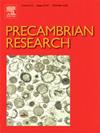Paleoproterozoic deep carbon cycle recorded in carbonatites
IF 3.2
2区 地球科学
Q2 GEOSCIENCES, MULTIDISCIPLINARY
引用次数: 0
Abstract
The deep carbon cycle regulates mantle-derived magma and atmospheric CO2 on geological timescales. However, the timing of initial carbon subduction into the mantle remains debated. Here, we compare the geochemical characteristics and origin of Paleoproterozoic Zhuozi and Fengzhen carbonatite-syenite complexes within the Trans-North China Orogen. The Zhuozi syenitic zircons have an older age than the Fengzhen samples (1941 vs 1810 Ma) and show unusually high δ18O (11.8 to 13.8 ‰) compared to most Paleoproterozoic igneous zircons. Their associated carbonatites have sediment-like δ13C (−1.8 to −1.0 ‰) and δ18O (10.7 to 18.0 ‰). Both rock types at Zhuozi have high εNdt (−1.4 to 2.8) and εHft (−2.0 to 5.0) values inconsistent with wall rock contamination, in contrast with the Fengzhen complex that has lower Nd-Hf isotopes. However, in-situ Pb isotopes of feldspars in Zhuozi syenites show more radiogenic compositions than the Fengzhen samples (207Pb/204Pb = 15.21–15.38 vs 14.84–14.95, 208Pb/204Pb = 35.06–35.56 vs 34.20–34.49). The Zhuozi and Fengzhen complexes may be products of Columbian supercontinent assembly. The differences of isotopic characteristics indicate that they originated from melting of depleted mantle wedge with sediment-derived fluid metasomatism and melting of deeply subducted sediment-bearing slab, respectively. This provides direct petrological and geochemical evidence for the onset of the Earth’s deep carbon cycle before 1.9 Ga, offering new insights into the carbonatite sources and the early history of the global carbon cycle.
碳酸盐岩中记录的古元古代深部碳循环
深部碳循环在地质时间尺度上调控着地幔源岩浆和大气CO2。然而,碳最初俯冲到地幔的时间仍然存在争议。对比了跨华北造山带古元古代卓子碳酸岩-正长岩杂岩的地球化学特征及成因。卓子正长锆石比丰镇锆石年龄更大(1941 ~ 1810 Ma), δ18O值比大多数古元古代火成岩锆石高(11.8 ~ 13.8‰)。其伴生碳酸盐岩具有沉积样δ13C(- 1.8 ~ - 1.0‰)和δ18O(10.7 ~ 18.0‰)。涿子两种岩石类型的εNdt(- 1.4 ~ 2.8)和εHft(- 2.0 ~ 5.0)值较高,与围岩污染不一致,而丰镇杂岩的Nd-Hf同位素较低。而涿子正长岩长石的原位Pb同位素显示出比丰镇样品更多的放射性成因成分(207Pb/204Pb = 15.21 ~ 15.38 vs 14.84 ~ 14.95, 208Pb/204Pb = 35.06 ~ 35.56 vs 34.20 ~ 34.49)。卓子杂岩和丰镇杂岩可能是哥伦比亚超大陆组合的产物。同位素特征的差异表明,它们分别源于贫地幔楔体与沉积流体交代作用的熔融作用和深俯冲含沉积板块的熔融作用。这为1.9 Ga以前地球深部碳循环的开始提供了直接的岩石学和地球化学证据,为碳酸盐来源和全球碳循环的早期历史提供了新的认识。
本文章由计算机程序翻译,如有差异,请以英文原文为准。
求助全文
约1分钟内获得全文
求助全文
来源期刊

Precambrian Research
地学-地球科学综合
CiteScore
7.20
自引率
28.90%
发文量
325
审稿时长
12 months
期刊介绍:
Precambrian Research publishes studies on all aspects of the early stages of the composition, structure and evolution of the Earth and its planetary neighbours. With a focus on process-oriented and comparative studies, it covers, but is not restricted to, subjects such as:
(1) Chemical, biological, biochemical and cosmochemical evolution; the origin of life; the evolution of the oceans and atmosphere; the early fossil record; palaeobiology;
(2) Geochronology and isotope and elemental geochemistry;
(3) Precambrian mineral deposits;
(4) Geophysical aspects of the early Earth and Precambrian terrains;
(5) Nature, formation and evolution of the Precambrian lithosphere and mantle including magmatic, depositional, metamorphic and tectonic processes.
In addition, the editors particularly welcome integrated process-oriented studies that involve a combination of the above fields and comparative studies that demonstrate the effect of Precambrian evolution on Phanerozoic earth system processes.
Regional and localised studies of Precambrian phenomena are considered appropriate only when the detail and quality allow illustration of a wider process, or when significant gaps in basic knowledge of a particular area can be filled.
 求助内容:
求助内容: 应助结果提醒方式:
应助结果提醒方式:


